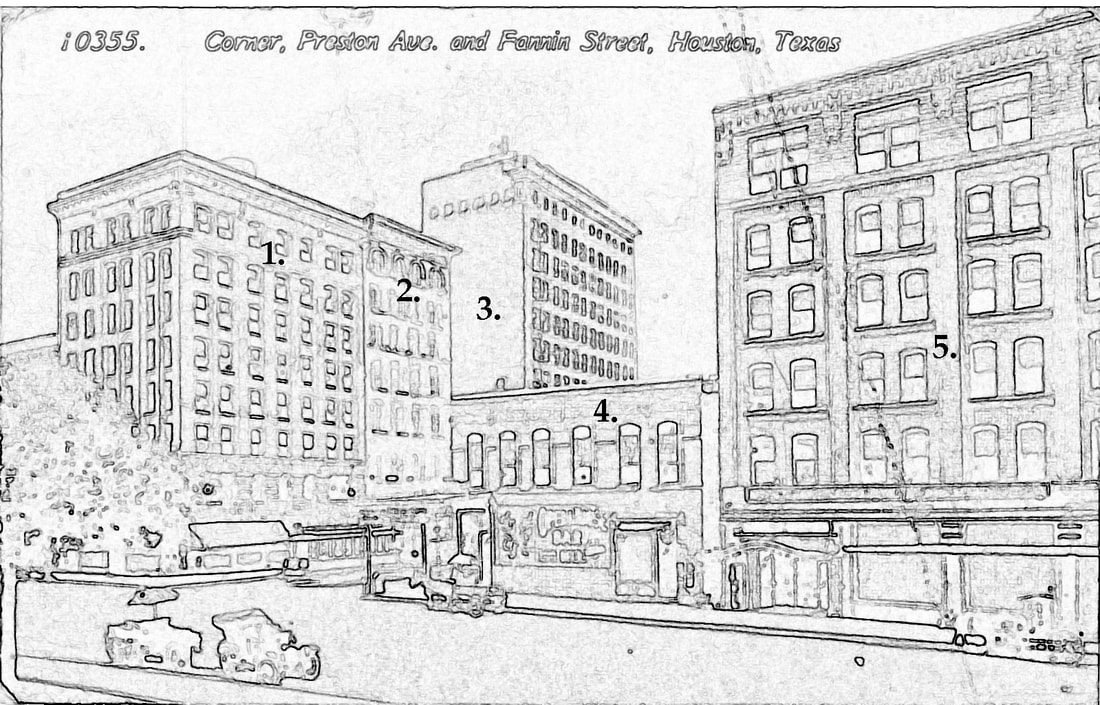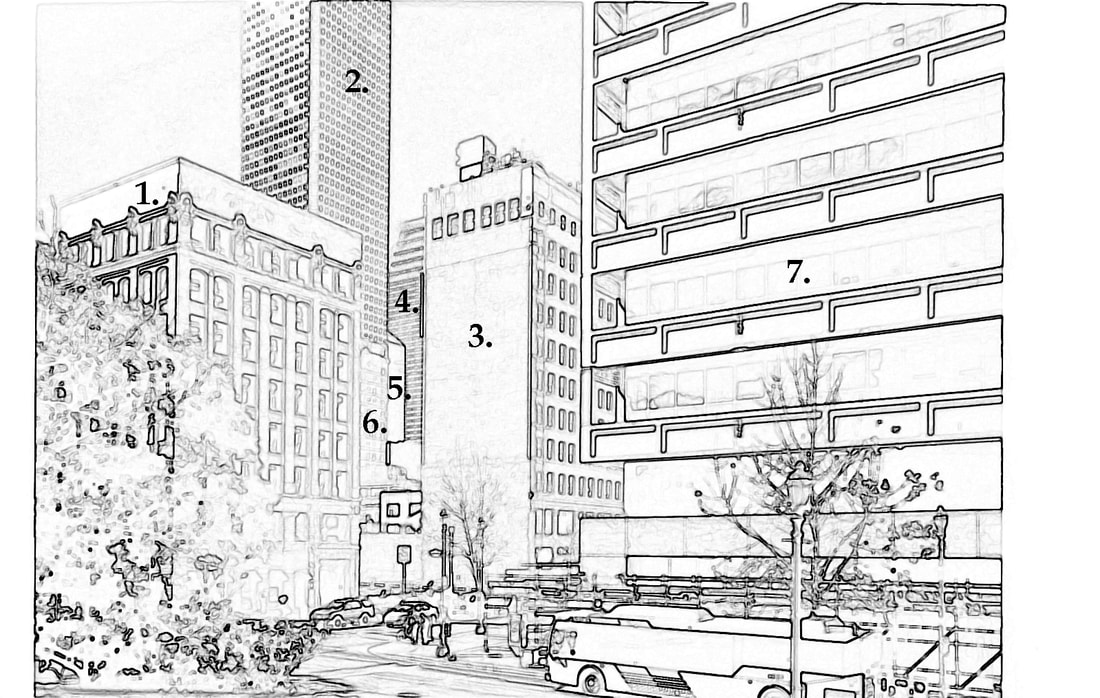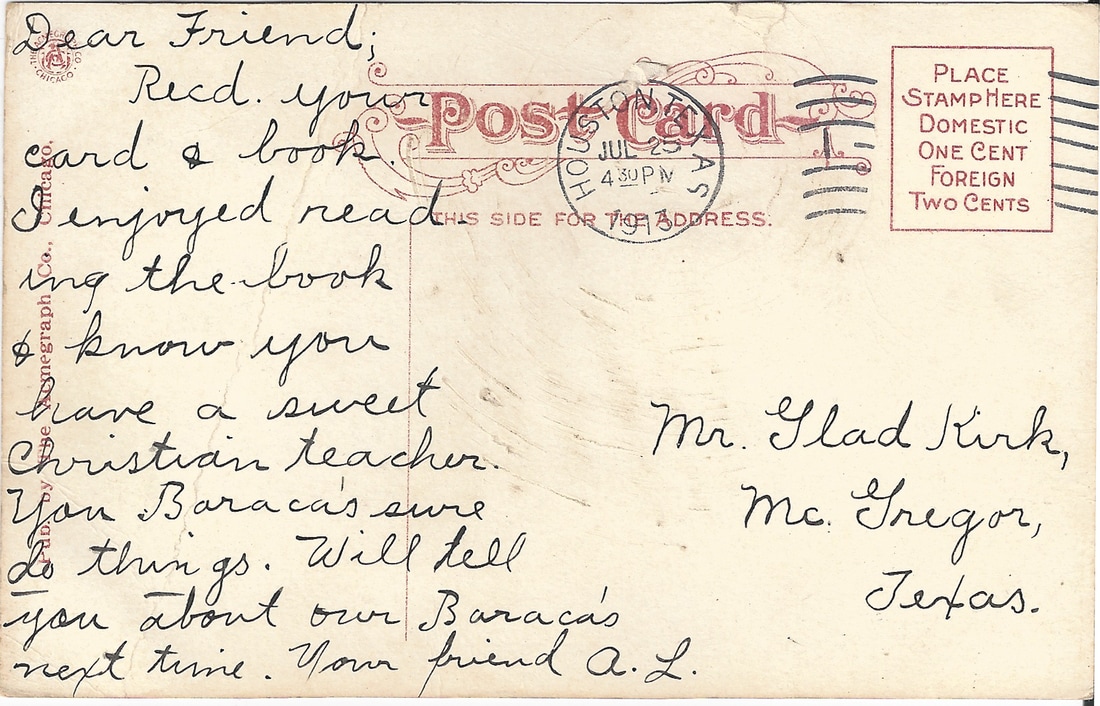Preston at Fannin
from the Court House
|
Postmarked: 25 July 1913; Houston, Texas
Stamp: removed To: Glad Kirk McGregor Texas Message: Dear Friend; Recd. Your card & book. I enjoyed reading the book & know you have a sweet Christian teacher. You Baraca’s sure do things. Will tell you about our Baraca’s next time. Your friend A. L. Glad Kirk was William Gladstone Kirk, born July 6, 1890 in McGregor, TX, the 23 year old son of William H. Kirk and Florence Ida Bell. He grew up in McGregor, working as a youth as a carpenter assisting his father in the family business. He was the eldest child, brother to Maude B. (2 years younger), Edna C. (6 years younger), Grace (7 years younger), Royal (9 years younger), and Edwin (14 years younger). He seems to have met his correspondent A. L. through a postcard exchange club [See Model Laundry for a reference to this exchange] and came to discover mutual interests, mostly related to church and other social activities. They exchanged postcards between March and December of 1913, and in the 16 cards in this collection, the author was more forthcoming than most correspondents in postcard exchanges, although they may never have met in person.
A few years after their exchange, Glad took a job as an express messenger for Wells Fargo and moved to Kansas City, MO. When registering for the draft in 1917 he was described as 6’ 1” tall with gray eyes and brown hair. Just before 1920 he would marry Shirley Marion King and move to Arkansas City, Cowley County, KS. Their son, William Edward Kirk, was born in Kansas City, KS in 1922. Glad would continue in this employment through 1930 (Tulsa, OK) and 1940 (Barry County, MO). Shirley King Kirk died in 1967, William Gladstone Kirk died in 1980 and they are buried at Monett IOOF Cemetery in Monett, Lawrence County, MO. |
The author of the postcards was Audrey Grace Lewis, born Mar 1890, daughter of Edward Lewis and Annie Laurie Nolan. In 1900 the Lewis family lived in 6th Ward neighborhood [See LINK Priester Harriet Lane for the discussion] at 1708 State Street where Edward was an insurance agent supporting a family of 4 children: daughter Cecil M. (b. 1887), Audrey (b. 1890), daughter Aline (b. 1894), and John Jay (b. 1898). [Neighbor to the family at 1717 Lubbock was Marie V. Tajan, also involved in postcard exchange groups, See Pythian Castle.]
Baraca organization mentioned in the message was a Protestant youth Christian group popular at the time all over the United States. A weekly Baraca Bulletin was published locally to inform the public of meetings all across town. Central Christian Church boasted a membership of 60 young people, and the First Methodist Episcopal Church had three times that many meeting on Sunday morning. Baraca had its origins in 1890 in Syracuse, NY where Marshall Hudson, a successful business man, wanted to provide activities promoting physical and intellectual growth for young men 16-25 to bring them back to the church through bible study. His daughter, May, began a similar program for young women called Philathea. The groups were organized and run by young people themselves, promoting activities that would engage youths on their own terms. By the early 1900’s groups met in almost every state in the Union and in Canada, Italy, England, India, and Japan. Audrey was 22 when she began the correspondence, about 4 months younger than Glad. Her father had died in 1908 just before her 12th birthday, making life difficult for the family. By 1910 they had moved to 219 Tuam where Annie reported that she did not work but had her own income. Things became even more difficult for the family when Annie died 16 months after the postcard exchange. Audrey’s sister Cecil died two years later of tuberculosis. World War I presented opportunities for Audrey to effect an escape, and she joined the military as a volunteer landsman yeoman in the US Navy, which sent her to Washington DC in the fall of 1918. Her younger brother John also served as a private in field artillery. Audrey was discharged in January 1919, but continued to be of service in 1920 when she worked as a stenographer in a sanitarium in San Antonio, TX. In 1921 her family once more shrank when her brother John died at age 24 of an intestinal obstruction. Audrey married a Danish immigrant, Oluf Jorgen Petersen Varder, some time after, and they lived at 1910 Hardy with Armand Teichman (who was informant on her brother’s 1921 death certificate) and Ida Bauman Teichman. Audrey died of a burst appendix on 12 November 1928, and her husband died five years later of pneumonia and heart failure complicated by cirrhosis of the liver and “lacas lues” (an outdated euphemistic term for syphillis). Magnolia Cemetery on West Dallas in Houston holds the remains of Audrey, her sister and brother, and parents. Her husband was buried in Rosewood Park Cemetery in Humble, TX. |



